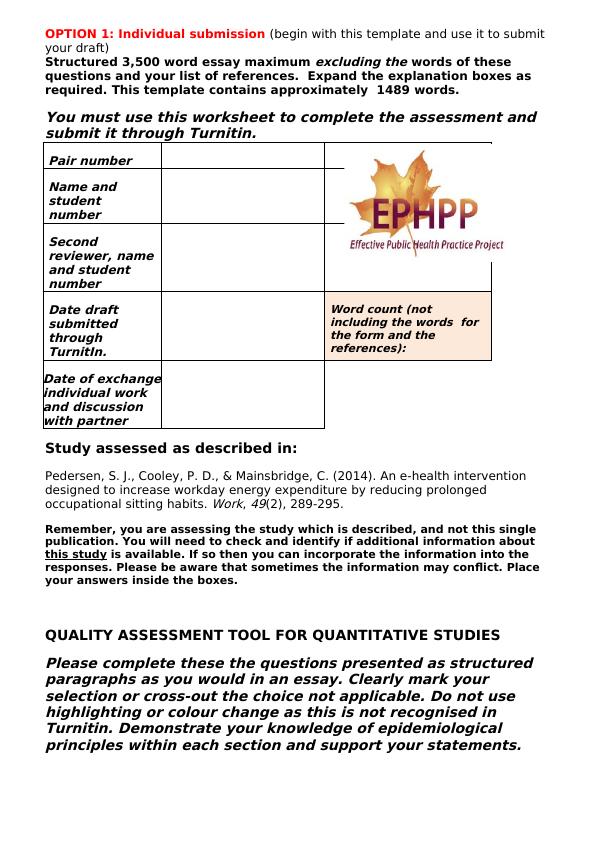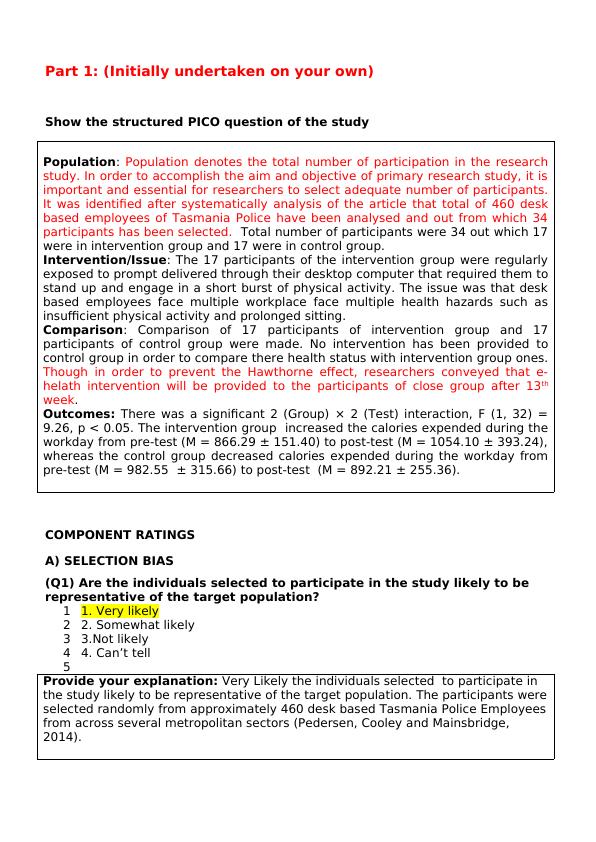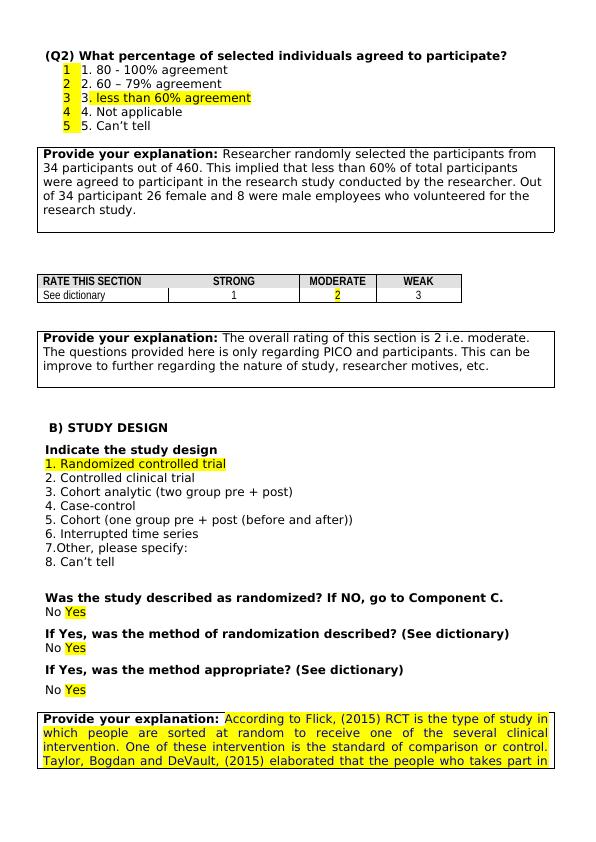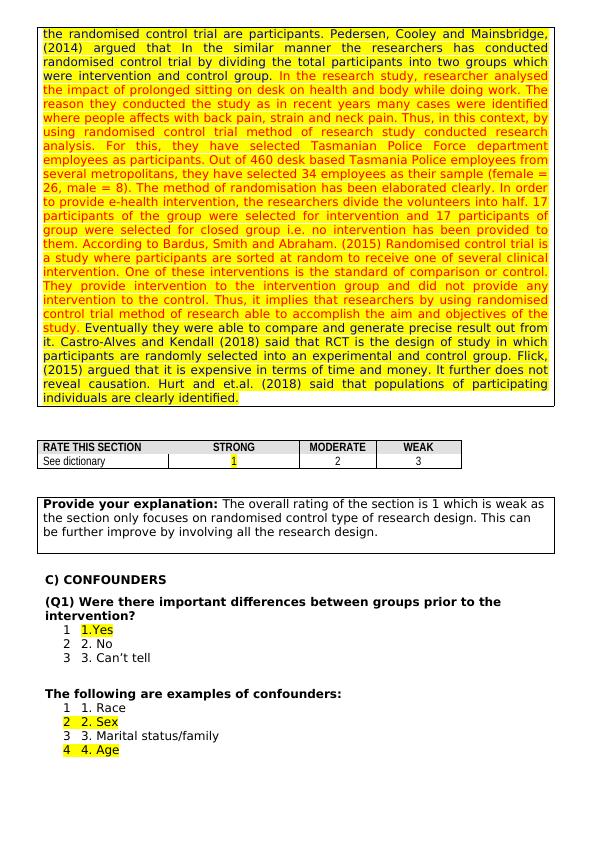Essay on Epidemiological Principles
15 Pages6456 Words21 Views
Added on 2020-06-04
Essay on Epidemiological Principles
Added on 2020-06-04
ShareRelated Documents
OPTION 1: Individual submission (begin with this template and use it to submit
your draft)
Structured 3,500 word essay maximum
excluding the words of these
questions and your list of references. Expand the explanation boxes as
required. This template contains approximately 1489 words.
You must use this worksheet to complete the assessment and
submit it through Turnitin.
Pair number
Name and
student
number
Second
reviewer, name
and student
number
Date draft
submitted
through
TurnitIn.
Word count (not
including the words for
the form and the
references):
Date of exchange
individual work
and discussion
with partner
Study assessed as described in:
Pedersen, S. J., Cooley, P. D., & Mainsbridge, C. (2014). An e-health intervention
designed to increase workday energy expenditure by reducing prolonged
occupational sitting habits.
Work,
49(2), 289-295.
Remember, you are assessing the study which is described, and not this single
publication. You will need to check and identify if additional information about
this study is available. If so then you can incorporate the information into the
responses. Please be aware that sometimes the information may conflict. Place
your answers inside the boxes.
QUALITY ASSESSMENT TOOL FOR QUANTITATIVE STUDIES
Please complete these the questions presented as structured
paragraphs as you would in an essay. Clearly mark your
selection or cross-out the choice not applicable. Do not use
highlighting or colour change as this is not recognised in
Turnitin. Demonstrate your knowledge of epidemiological
principles within each section and support your statements.
your draft)
Structured 3,500 word essay maximum
excluding the words of these
questions and your list of references. Expand the explanation boxes as
required. This template contains approximately 1489 words.
You must use this worksheet to complete the assessment and
submit it through Turnitin.
Pair number
Name and
student
number
Second
reviewer, name
and student
number
Date draft
submitted
through
TurnitIn.
Word count (not
including the words for
the form and the
references):
Date of exchange
individual work
and discussion
with partner
Study assessed as described in:
Pedersen, S. J., Cooley, P. D., & Mainsbridge, C. (2014). An e-health intervention
designed to increase workday energy expenditure by reducing prolonged
occupational sitting habits.
Work,
49(2), 289-295.
Remember, you are assessing the study which is described, and not this single
publication. You will need to check and identify if additional information about
this study is available. If so then you can incorporate the information into the
responses. Please be aware that sometimes the information may conflict. Place
your answers inside the boxes.
QUALITY ASSESSMENT TOOL FOR QUANTITATIVE STUDIES
Please complete these the questions presented as structured
paragraphs as you would in an essay. Clearly mark your
selection or cross-out the choice not applicable. Do not use
highlighting or colour change as this is not recognised in
Turnitin. Demonstrate your knowledge of epidemiological
principles within each section and support your statements.

Part 1: (Initially undertaken on your own)
Show the structured PICO question of the study
Population: Population denotes the total number of participation in the research
study. In order to accomplish the aim and objective of primary research study, it is
important and essential for researchers to select adequate number of participants.
It was identified after systematically analysis of the article that total of 460 desk
based employees of Tasmania Police have been analysed and out from which 34
participants has been selected. Total number of participants were 34 out which 17
were in intervention group and 17 were in control group.
Intervention/Issue: The 17 participants of the intervention group were regularly
exposed to prompt delivered through their desktop computer that required them to
stand up and engage in a short burst of physical activity. The issue was that desk
based employees face multiple workplace face multiple health hazards such as
insufficient physical activity and prolonged sitting.
Comparison: Comparison of 17 participants of intervention group and 17
participants of control group were made. No intervention has been provided to
control group in order to compare there health status with intervention group ones.
Though in order to prevent the Hawthorne effect, researchers conveyed that e-
helath intervention will be provided to the participants of close group after 13th
week.
Outcomes: There was a significant 2 (Group) × 2 (Test) interaction, F (1, 32) =
9.26, p < 0.05. The intervention group increased the calories expended during the
workday from pre-test (M = 866.29 ± 151.40) to post-test (M = 1054.10 ± 393.24),
whereas the control group decreased calories expended during the workday from
pre-test (M = 982.55 ± 315.66) to post-test (M = 892.21 ± 255.36).
COMPONENT RATINGS
A) SELECTION BIAS
(Q1) Are the individuals selected to participate in the study likely to be
representative of the target population?
1 1. Very likely
2 2. Somewhat likely
3 3.Not likely
4 4. Can’t tell
5
Provide your explanation: Very Likely the individuals selected to participate in
the study likely to be representative of the target population. The participants were
selected randomly from approximately 460 desk based Tasmania Police Employees
from across several metropolitan sectors (Pedersen, Cooley and Mainsbridge,
2014).
Show the structured PICO question of the study
Population: Population denotes the total number of participation in the research
study. In order to accomplish the aim and objective of primary research study, it is
important and essential for researchers to select adequate number of participants.
It was identified after systematically analysis of the article that total of 460 desk
based employees of Tasmania Police have been analysed and out from which 34
participants has been selected. Total number of participants were 34 out which 17
were in intervention group and 17 were in control group.
Intervention/Issue: The 17 participants of the intervention group were regularly
exposed to prompt delivered through their desktop computer that required them to
stand up and engage in a short burst of physical activity. The issue was that desk
based employees face multiple workplace face multiple health hazards such as
insufficient physical activity and prolonged sitting.
Comparison: Comparison of 17 participants of intervention group and 17
participants of control group were made. No intervention has been provided to
control group in order to compare there health status with intervention group ones.
Though in order to prevent the Hawthorne effect, researchers conveyed that e-
helath intervention will be provided to the participants of close group after 13th
week.
Outcomes: There was a significant 2 (Group) × 2 (Test) interaction, F (1, 32) =
9.26, p < 0.05. The intervention group increased the calories expended during the
workday from pre-test (M = 866.29 ± 151.40) to post-test (M = 1054.10 ± 393.24),
whereas the control group decreased calories expended during the workday from
pre-test (M = 982.55 ± 315.66) to post-test (M = 892.21 ± 255.36).
COMPONENT RATINGS
A) SELECTION BIAS
(Q1) Are the individuals selected to participate in the study likely to be
representative of the target population?
1 1. Very likely
2 2. Somewhat likely
3 3.Not likely
4 4. Can’t tell
5
Provide your explanation: Very Likely the individuals selected to participate in
the study likely to be representative of the target population. The participants were
selected randomly from approximately 460 desk based Tasmania Police Employees
from across several metropolitan sectors (Pedersen, Cooley and Mainsbridge,
2014).

(Q2) What percentage of selected individuals agreed to participate?
1 1. 80 - 100% agreement
2 2. 60 – 79% agreement
3 3. less than 60% agreement
4 4. Not applicable
5 5. Can’t tell
Provide your explanation: Researcher randomly selected the participants from
34 participants out of 460. This implied that less than 60% of total participants
were agreed to participant in the research study conducted by the researcher. Out
of 34 participant 26 female and 8 were male employees who volunteered for the
research study.
RATE THIS SECTION STRONG MODERATE WEAK
See dictionary 1 2 3
Provide your explanation: The overall rating of this section is 2 i.e. moderate.
The questions provided here is only regarding PICO and participants. This can be
improve to further regarding the nature of study, researcher motives, etc.
B) STUDY DESIGN
Indicate the study design
1. Randomized controlled trial
2. Controlled clinical trial
3. Cohort analytic (two group pre + post)
4. Case-control
5. Cohort (one group pre + post (before and after))
6. Interrupted time series
7.Other, please specify:
8. Can’t tell
Was the study described as randomized? If NO, go to Component C.
No Yes
If Yes, was the method of randomization described? (See dictionary)
No Yes
If Yes, was the method appropriate? (See dictionary)
No Yes
Provide your explanation: According to Flick, (2015) RCT is the type of study in
which people are sorted at random to receive one of the several clinical
intervention. One of these intervention is the standard of comparison or control.
Taylor, Bogdan and DeVault, (2015) elaborated that the people who takes part in
1 1. 80 - 100% agreement
2 2. 60 – 79% agreement
3 3. less than 60% agreement
4 4. Not applicable
5 5. Can’t tell
Provide your explanation: Researcher randomly selected the participants from
34 participants out of 460. This implied that less than 60% of total participants
were agreed to participant in the research study conducted by the researcher. Out
of 34 participant 26 female and 8 were male employees who volunteered for the
research study.
RATE THIS SECTION STRONG MODERATE WEAK
See dictionary 1 2 3
Provide your explanation: The overall rating of this section is 2 i.e. moderate.
The questions provided here is only regarding PICO and participants. This can be
improve to further regarding the nature of study, researcher motives, etc.
B) STUDY DESIGN
Indicate the study design
1. Randomized controlled trial
2. Controlled clinical trial
3. Cohort analytic (two group pre + post)
4. Case-control
5. Cohort (one group pre + post (before and after))
6. Interrupted time series
7.Other, please specify:
8. Can’t tell
Was the study described as randomized? If NO, go to Component C.
No Yes
If Yes, was the method of randomization described? (See dictionary)
No Yes
If Yes, was the method appropriate? (See dictionary)
No Yes
Provide your explanation: According to Flick, (2015) RCT is the type of study in
which people are sorted at random to receive one of the several clinical
intervention. One of these intervention is the standard of comparison or control.
Taylor, Bogdan and DeVault, (2015) elaborated that the people who takes part in

the randomised control trial are participants. Pedersen, Cooley and Mainsbridge,
(2014) argued that In the similar manner the researchers has conducted
randomised control trial by dividing the total participants into two groups which
were intervention and control group. In the research study, researcher analysed
the impact of prolonged sitting on desk on health and body while doing work. The
reason they conducted the study as in recent years many cases were identified
where people affects with back pain, strain and neck pain. Thus, in this context, by
using randomised control trial method of research study conducted research
analysis. For this, they have selected Tasmanian Police Force department
employees as participants. Out of 460 desk based Tasmania Police employees from
several metropolitans, they have selected 34 employees as their sample (female =
26, male = 8). The method of randomisation has been elaborated clearly. In order
to provide e-health intervention, the researchers divide the volunteers into half. 17
participants of the group were selected for intervention and 17 participants of
group were selected for closed group i.e. no intervention has been provided to
them. According to Bardus, Smith and Abraham. (2015) Randomised control trial is
a study where participants are sorted at random to receive one of several clinical
intervention. One of these interventions is the standard of comparison or control.
They provide intervention to the intervention group and did not provide any
intervention to the control. Thus, it implies that researchers by using randomised
control trial method of research able to accomplish the aim and objectives of the
study. Eventually they were able to compare and generate precise result out from
it. Castro-Alves and Kendall (2018) said that RCT is the design of study in which
participants are randomly selected into an experimental and control group. Flick,
(2015) argued that it is expensive in terms of time and money. It further does not
reveal causation. Hurt and et.al. (2018) said that populations of participating
individuals are clearly identified.
RATE THIS SECTION STRONG MODERATE WEAK
See dictionary 1 2 3
Provide your explanation: The overall rating of the section is 1 which is weak as
the section only focuses on randomised control type of research design. This can
be further improve by involving all the research design.
C) CONFOUNDERS
(Q1) Were there important differences between groups prior to the
intervention?
1 1.Yes
2 2. No
3 3. Can’t tell
The following are examples of confounders:
1 1. Race
2 2. Sex
3 3. Marital status/family
4 4. Age
(2014) argued that In the similar manner the researchers has conducted
randomised control trial by dividing the total participants into two groups which
were intervention and control group. In the research study, researcher analysed
the impact of prolonged sitting on desk on health and body while doing work. The
reason they conducted the study as in recent years many cases were identified
where people affects with back pain, strain and neck pain. Thus, in this context, by
using randomised control trial method of research study conducted research
analysis. For this, they have selected Tasmanian Police Force department
employees as participants. Out of 460 desk based Tasmania Police employees from
several metropolitans, they have selected 34 employees as their sample (female =
26, male = 8). The method of randomisation has been elaborated clearly. In order
to provide e-health intervention, the researchers divide the volunteers into half. 17
participants of the group were selected for intervention and 17 participants of
group were selected for closed group i.e. no intervention has been provided to
them. According to Bardus, Smith and Abraham. (2015) Randomised control trial is
a study where participants are sorted at random to receive one of several clinical
intervention. One of these interventions is the standard of comparison or control.
They provide intervention to the intervention group and did not provide any
intervention to the control. Thus, it implies that researchers by using randomised
control trial method of research able to accomplish the aim and objectives of the
study. Eventually they were able to compare and generate precise result out from
it. Castro-Alves and Kendall (2018) said that RCT is the design of study in which
participants are randomly selected into an experimental and control group. Flick,
(2015) argued that it is expensive in terms of time and money. It further does not
reveal causation. Hurt and et.al. (2018) said that populations of participating
individuals are clearly identified.
RATE THIS SECTION STRONG MODERATE WEAK
See dictionary 1 2 3
Provide your explanation: The overall rating of the section is 1 which is weak as
the section only focuses on randomised control type of research design. This can
be further improve by involving all the research design.
C) CONFOUNDERS
(Q1) Were there important differences between groups prior to the
intervention?
1 1.Yes
2 2. No
3 3. Can’t tell
The following are examples of confounders:
1 1. Race
2 2. Sex
3 3. Marital status/family
4 4. Age

End of preview
Want to access all the pages? Upload your documents or become a member.
Related Documents
Preventing weight-related problems in adolescent girls through physical education and motivational interviewlg...
|12
|6095
|284
An Assessment Template for a 3500 Word Essaylg...
|13
|6054
|341
Health Psychology Assignmentlg...
|14
|5968
|81
An Assessment Template for a 3,500-word Essaylg...
|14
|5998
|299
Quality Assessment of a Quantitative Study on Contingency Management for Smoking Cessationlg...
|11
|5244
|87
Quality Assessment Tool for Quantitative Studieslg...
|9
|2804
|347
